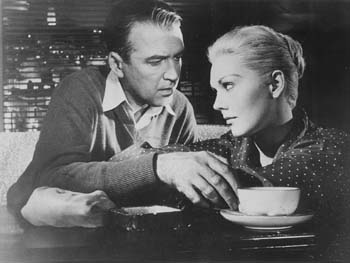![[MetroActive Movies]](http://metroactive.com/movies/gifs/movies468.gif)
[ Movies Index | SF Metropolitan | MetroActive Central | Archives ]
Hitchcock's Highs and Lows
New prints of 13 films from the beloved director
By Richard von Busack
If you've ever read defenses of Alfred Hitchcock's lesser work, you may be reminded of humorist Tom Lehrer's phrase about the special pain of a Christian Scientist stricken with appendicitis. The 13 films by Hitchcock in new prints (continuing at the Castro Theater through April 8) show the director at his best and worst--often in juxtapositions a day apart. The retrospective, titled "Universal Hitchcock," has so far offered up gems. One was the original black-and-white Psycho (1960; March 26-29), a low-budget, low-tech triumph made with a TV-studio crew, a string quartet soundtrack and, most irreproducible, the beautiful, agonized Anthony Perkins, reminding viewers of what a gross hambone Vince Vaughn is. The minifestival has featured the best movie ever made in Bodega Bay, 1963's The Birds (March 19-22), followed by the best movie ever made in Santa Rosa, 1943's Shadow of a Doubt (March 24-25), and now the best movie made in San Francisco, 1958's Vertigo, in 70mm (April 2-5).
But the festival also includes bottom-of-the-barrel Hitch: April 6, one day only, and strictly for the most high-church Hitchcock fans, Torn Curtain (1966) and Topaz (1969), a pair of dingy spy films. They are evidence that not every work by a master is a masterwork. The tediousness, the ugly rear projection, the cheap look of the color and the sets at Universal during its poor-faced days in the late '60s are all there, framed with the thespian gifts of Julie Andrews and John Forsythe. Frenzy (1972; April 7) has its partisans, but this grisly piece about a mad rapist exists mostly as proof that those old enough to remember early-'70s cinema will never be shocked again as long as they live. They had rape scenes in those days. Some directors weren't happy unless the whole audience was ready to check into a crisis-counseling center after the movie was over.
Amid these lesser, often roundly bad, films, one late-period Hitchcock film is especially worth a new visit--his last film, the shaggy, charming Family Plot (1976; April 8). Scriptwriter Ernest Lehman was first getting used to the idea that you could swear in a movie script. All the characters, except Bruce Dern (the hero!), have a catch in their voice as they use a bad word--it's so cute. Again, Hitchcock is addicted to the cheapest rear projection. It's depressing how out of touch the director was getting; Family Plot was made two long years after Steven Spielberg's Sugarland Express demonstrated the amount of visual drama you could create inside a moving car.
But I meant to praise this pleasant movie. The appealing comedienne Barbara Harris demonstrates her fake psychic skills with a gravelly "spirit" voice that sounds like Paul Williams' portly rasp. The patrician William Devane, our diamond-thieving villain, is mustachioed, looking like Badger in an inexpensive production of Wind in the Willows.
Best of all is Karen Black. At first, Black is an Irma Vep figure, a black-trench-coat-clad and sunglasses-wearing master criminaless. Later, she turns jittery, overcome by a quantity of spilled blood that wouldn't fill a syringe. The film is a breezy con game, full of impostors. The heroine winks at the audience at the end of the film. (Family Plot is playing with a natural counterpart, 1955's The Trouble With Harry.)
I've never seen 1964's Marnie (March 31-April 1), and I've been waiting for just such an opportunity as this new print on the Castro's big screen. The elements are kleptomania and a terror of the color scarlet in a preorgasmic woman. This cult film is billed with a trick film, Rope (1948), one of those public-service warnings against the Nietzschean fallacy that Supermen ought to be allowed to kill lesser human beings. Stage-bound as it is, Rope features the most distracting diorama in movie history, a wonderful model of New York City with thousands of real windows and spun-glass clouds.
But there's nothing quaint about Hitchcock's great (greatest?) film Vertigo. The subject is a murder plot, disguised as a story of old curses coming home to roost. It's set among the heights and abysses of San Francisco--where else can you rise so high or fall so hard? The center of the story is an aging man (Jimmy Stewart) feeling love and sanity slip through his fingers. This might have been an allegory of Hitchcock facing age, though, to frequent viewers, the film tells of being drawn helplessly to memories of past love and trauma. Unlike the solution in most atmospheric mysteries, this one is not a disappointment. In Vertigo, Hitchcock was tangling with the proverbial fates worse than death. The mask of the smooth, kindly bourgeois entertainer falls and shows a grief too deep for words.
[ San Francisco | MetroActive Central | Archives ]
Copyright © Metro Publishing Inc. Maintained by Boulevards New Media.
![]()

'Coit'-us Interruptus: Stewart and Novak rise high and fall hard in the mysterious shadow of San Francisco.
From the March 29, 1999 issue of the Metropolitan.